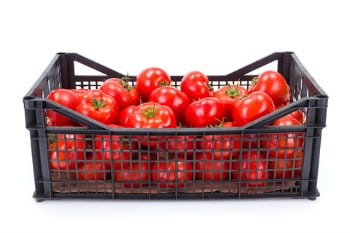 The corrugated box. The wood crate. The five-gallon pail. These products have been used to ship and store food ever since we started sending it further than the local farm stand. But another option is gaining popularity — reusable bulk containers.
The corrugated box. The wood crate. The five-gallon pail. These products have been used to ship and store food ever since we started sending it further than the local farm stand. But another option is gaining popularity — reusable bulk containers.
Reusable totes and crates are already commonly used in applications like motor vehicle manufacturing and assembly due to the long-term cost savings of container reuse.
However, reusable bulk systems are now seeing wider adoption in food applications, such as for the transport and display of fresh produce or baked goods. Where you used to see a wood crate or a printed corrugated box, plastic containers are gaining speed, especially for large volume users who are looking to minimize waste and promote environmentally friendly practices.
Within the past few years, crates have even been used to ship and store fruit concentrates and purees with the advancement of technologies that allow for their use with liquid products. Overall, the demand for reusable totes and crates in the food and beverage industry has grown nearly 5% per year since 2005.
Sharing economy for shipping and display
How have reusable systems gained so much ground in over the past decade? The answer lies in pooling and third-party container management. Firms that offer these services, such as CHEP, own a fleet of containers which are rented out by individual users to ship their goods from farms or processing facilities to supermarkets across the country. After each use, the container is cleaned and then shipped off to pick up and display another round of goods for another user.
The use of a pooling system has a number of benefits for the user, including the ability to spread out the expense of using these containers. As you might imagine, a plastic container that is designed to look like a wood crate is more expensive than a wood crate. Containers also have to be cleaned thoroughly between each use to prevent cross-contamination, especially in fresh produce applications. Though some growers and distributors can manage cleaning, transportation, the logistical challenges of container reuse internally, most have only been able to adopt reusable containers thanks to firms that handle all these details for them.
There are some disadvantages to pooling for users, primarily involving the risk associated with having a third party manage your goods. If the relationship goes bad, it’s not easy to take over management internally. Compounding this issue is the fact that the container management industry is fairly concentrated with only two major nationwide providers, CHEP and Polymer Logistics.
However, the cost benefits and logistical ease of using these services has led to more and more companies willing to give it a shot for the chance at a streamlined supply chain and an improved environmental footprint.
More applications lead to gains for suppliers
Pooling has also helped out producers of reusable systems. These new users and applications typically could not justify the large upfront investment or have the resources necessary to implement and manage their own reusable closed loop systems, according to Dan Huhn, a sales manager for Buckhorn, a major manufacturer of plastic totes and crates. This growth in applications and the expanding user base more than compensates for the fact that these users aren’t always investing in their own fleet right away.
“Pooling also gives customers options,” Huhn explains. “They may be using pooled containers today, but they might decide to switch to using their own at some point in the future. Or vice versa. Customers may even use both pooled containers and closed loop pools for different applications at the same time.”
For more information on this and other trends in the industrial packaging market, check out the market research report Rigid Bulk Packaging by The Freedonia Group.
About the Author: Katie Wieser is an Industry Analyst at the Freedonia Group, a leading international market research company and a division of MarketResearch.com.


